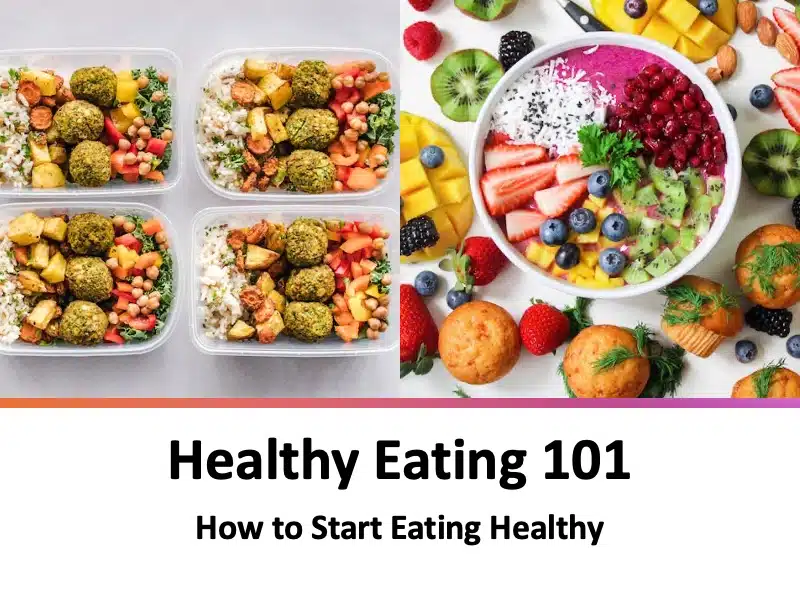Healthy Eating 101: How to Start Eating Healthy
Nutrition forms the bedrock of vibrant health, peak physical performance, and longevity.
A balanced, nutrient-dense diet improves energy, supports mental clarity, and dramatically reduces the risk of chronic illness (Mozaffarian et al., 2018).
Yet, despite the overwhelming evidence supporting healthy eating, many individuals struggle due to conflicting advice, restrictive trends, and the overwhelming presence of ultra-processed foods.
As a professional athlete and nutrition educator, I’ve spent years decoding what truly works and what “healthy eating” actually means.
Healthy eating isn’t about strict meal plans or deprivation.
It’s about cultivating sustainable habits that nourish your body, fuel your performance, and support an enjoyable, balanced life!
Read below to learn how to start eating healthy with simple, actionable tips!
What Is Healthy Eating?
Healthy eating is the practice of fueling your body with a variety of nutrient-dense foods that support energy, recovery, mental clarity, immune function, and long-term disease prevention.
It means choosing whole, minimally processed foods most of the time—while still allowing flexibility for enjoyment and balance.
A healthy, balanced diet includes a thoughtful mix of macronutrients (carbohydrates, proteins, fats), micronutrients (vitamins and minerals), fiber, and adequate hydration. It supports not just physical performance but also mood, focus, sleep quality, and metabolic function.
Importantly, healthy eating isn’t about perfection or rigid rules.
It’s about developing sustainable habits that align with your personal needs, preferences, lifestyle, and goals—while promoting a positive, flexible relationship with food.
What Are the Benefits of Healthy Eating?
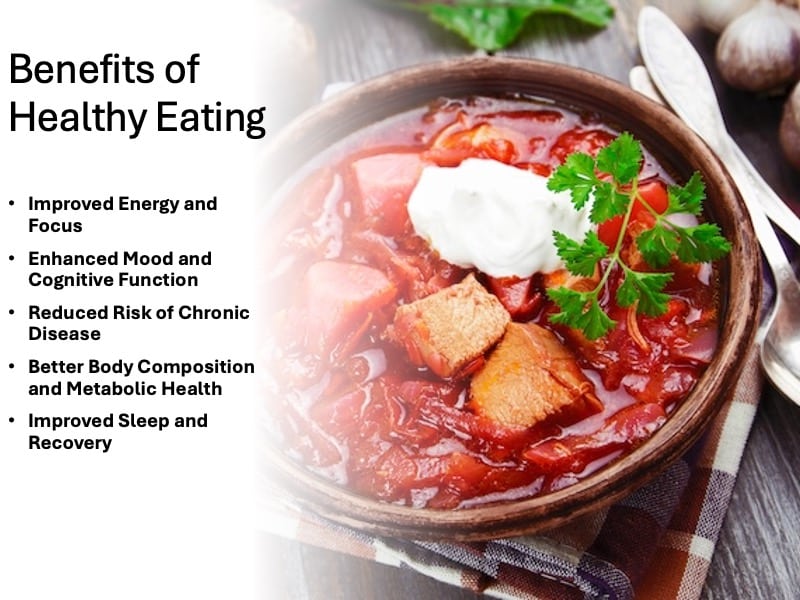
Healthy eating provides a powerful foundation for physical, mental, and emotional well-being.
Consistently consuming nutrient-rich, whole foods improves energy levels, stabilizes mood, sharpens focus, and enhances immune function.
It also supports optimal digestion, hormonal balance, and long-term weight management—without the need for restrictive dieting.
Over time, a healthy diet significantly reduces the risk of chronic conditions such as heart disease, type 2 diabetes, hypertension, and certain cancers (Mozaffarian et al., 2018).
It also promotes healthy aging by protecting against inflammation, preserving muscle mass, and supporting cognitive health.
Beyond the physical, eating well enhances quality of life—improving sleep, reducing anxiety and depression symptoms, and helping you perform at your best in daily tasks, workouts, or high-stress situations.
Whether you’re pursuing athletic performance, longevity, or everyday vitality, nutrition is one of your most effective tools.
Core Components of a Healthy Diet
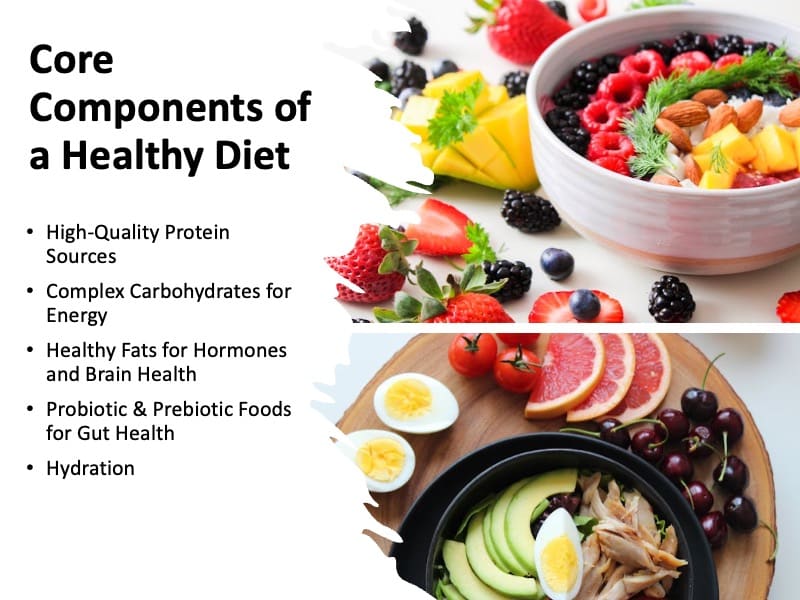
Understanding the building blocks of a balanced diet is essential for creating lasting healthy eating habits.
Each macronutrient and micronutrient plays a unique role in supporting energy levels, metabolic function, immunity, recovery, and cognitive performance.
By prioritizing whole, nutrient-dense foods across all categories—proteins, carbohydrates, fats, fiber, and hydration—you can fuel your body efficiently and protect against chronic disease.
The following components form the nutritional foundation of a sustainable, high-performance lifestyle.
High-Quality Protein Sources
Protein supports muscle repair, immune function, and metabolic health. Combining plant and animal-based proteins ensures amino acid variety and nutrient synergy.
- Plant Protein Sources: Lentils, beans, quinoa, tempeh, tofu, seeds
- Animal Proteins: Grass-fed beef, poultry, eggs, fish, Greek yogurt
Expert Insight: Protein helps regulate appetite and preserve muscle during weight loss, especially when paired with strength training.
Complex Carbohydrates for Energy
Carbohydrates fuel the brain and muscles. Prioritize complex, fiber-rich sources that stabilize blood sugar and improve gut health.
- Whole Grains: Oats, brown rice, quinoa, sprouted breads
- Fruits & Vegetables: Berries, apples, leafy greens, root vegetables
- Legumes: Chickpeas, lentils, black beans
Quick Tip: Research indicates that the quality of your carbohydrates is more important than quantity. Focus on slow-digesting complex carbohydrates that nourish the microbiome.
Healthy Fats for Hormones and Brain Health
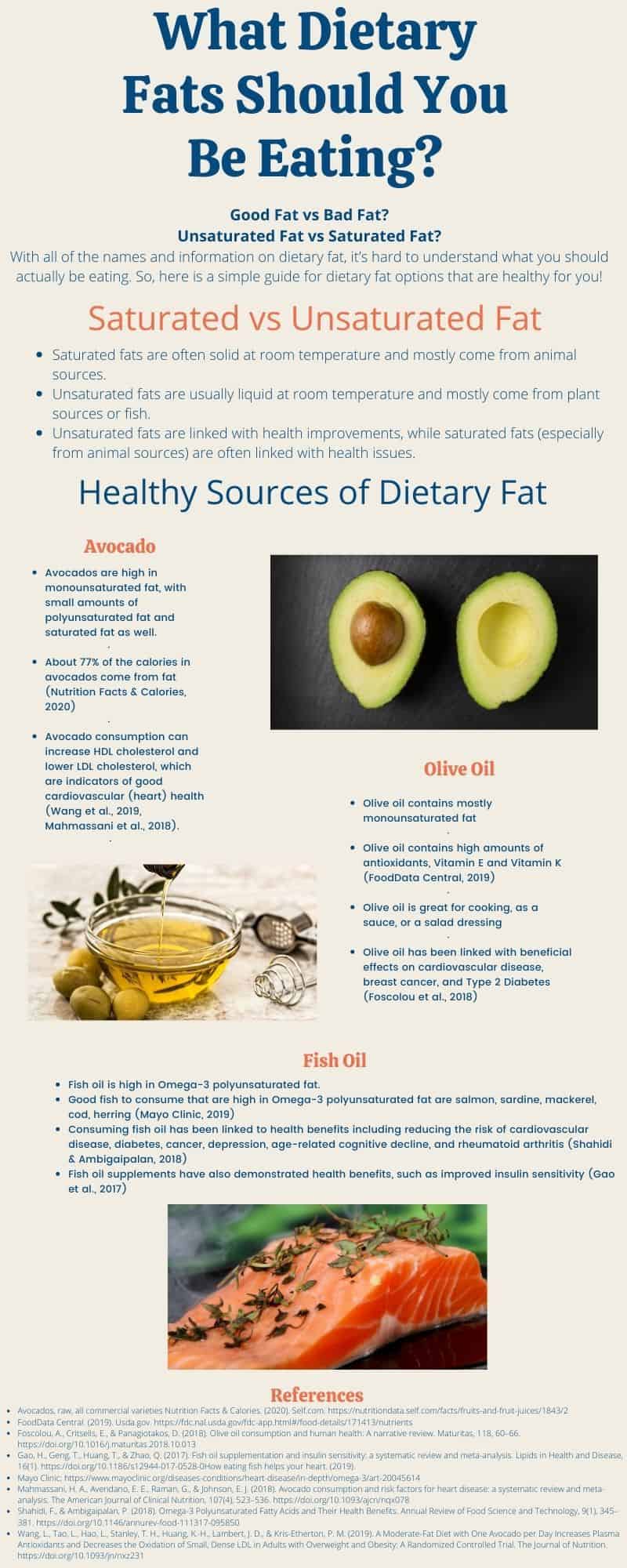
Dietary fats are crucial for hormone production, brain function, and anti-inflammatory balance. Don’t fear fat—choose the right kinds.
- Monounsaturated Fats: Avocados, olive oil, almonds
- Omega-3s: Fatty fish (salmon, mackerel), walnuts, flaxseed
- Saturated Fats (Moderation): Grass-fed butter, coconut oil
Science-Backed Fact: Diets higher in unsaturated fats, like those found in olive oil, reduce cardiovascular risk compared to low-fat diets (Mozaffarian et al., 2010).
Probiotic & Prebiotic Foods for Gut Health
The gut microbiome plays a vital role in digestion, immunity, metabolism, and even mood.
A balanced diet includes both probiotics (beneficial bacteria) and prebiotics (food for those bacteria).
- Probiotic-Rich Foods: Greek yogurt, kefir, kimchi, sauerkraut, kombucha
- Prebiotic Foods: Garlic, onions, bananas, oats, flaxseeds, Jerusalem artichokes
Why It Matters: Gut dysbiosis is linked with inflammation, weight gain, and mental health disorders. A diverse gut microbiota supports resilience and overall health.
Hydration
Hydration and staying hydrated is one of the pillars of healthy eating.
Water is essential for nutrient transport, temperature regulation, and joint function. Dehydration leads to fatigue, poor concentration, and decreased performance.
- Best Hydration Drinks: Filtered water, herbal teas, coconut water, homemade electrolyte mixes
Pro Tip: Start your day with a glass of water and aim for consistent intake throughout the day. Check urine color—pale yellow is ideal.
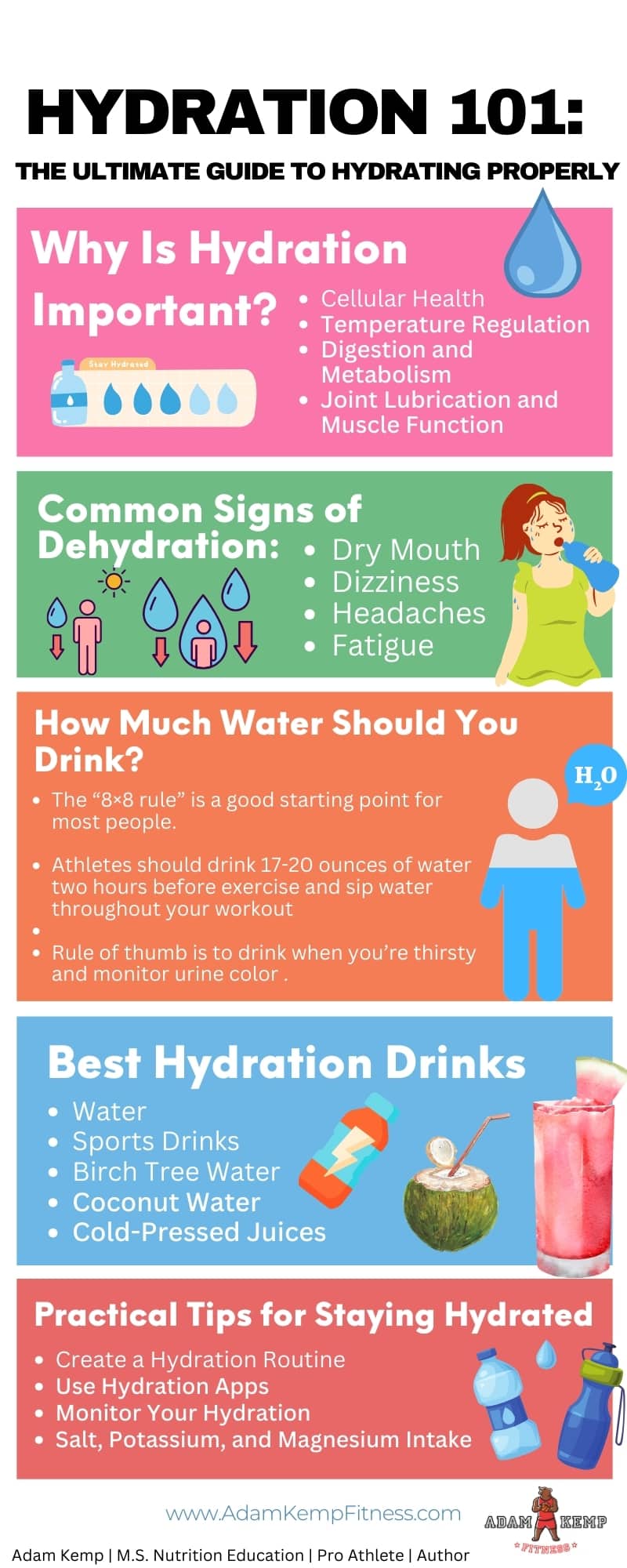
Foods and Ingredients to Limit
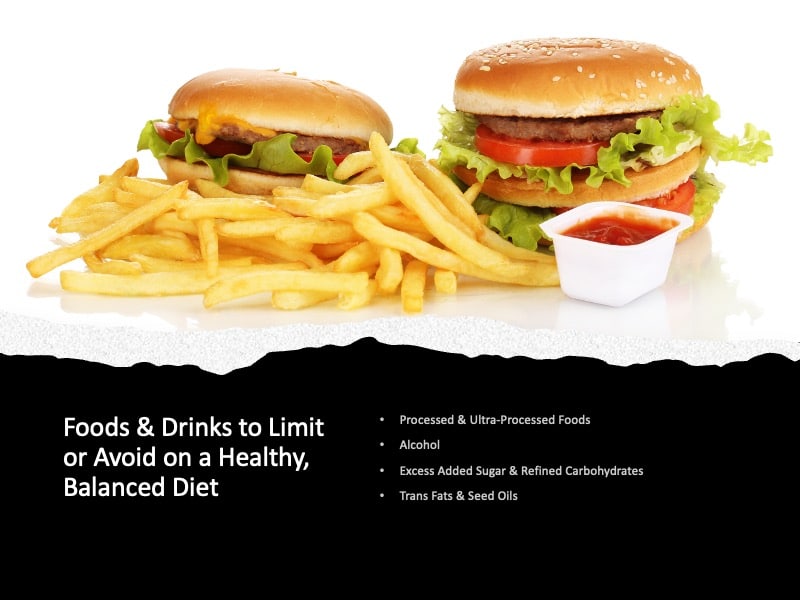
While no food should be labeled as strictly “off-limits,” there are clear culprits that harm long-term health and digestive balance when consumed regularly:
- Ultra-Processed Foods: Chips, sugary cereals, microwave meals
- Trans Fats & Refined Seed Oils: Found in many packaged snacks and fried foods
- Excess Sugar & Refined Grains: Candy, white bread, pastries, soda
- Alcohol (Excessive Use): Impairs digestion, recovery, and nutrient absorption
Rule of Thumb: Eat whole foods most of the time, indulge occasionally, and always prioritize how food makes your body feel.
Beneficial Supplements to Fill Nutritional Gaps
When comparing supplements vs whole foods, whole foods should always be the foundation. However, strategic supplementation can support healthy eating by filling gaps in a modern diet or meeting increased needs due to stress, training, or environmental factors.
Additionally, some supplements provide increased amounts of valuable compounds or nutrients that support health in ways whole foods alone cannot.
Here are a few important supplements you may want to consider using:
Helpful Supplements:
- Protein Powder: Convenient recovery tool post-workout
- Omega-3s: For anti-inflammatory support and brain health
- Vitamin D Supplements: Immune and bone support, especially in winter
- Magnesium Supplements: Helps with sleep, recovery, and muscle relaxation
- Creatine Monohydrate: Improves athletic performance and brain energy metabolism
Note: Choose high-quality, third-party-tested supplements from trusted brands. Read my Supplements Guide to learn more about the types of supplements available and how to choose the best options.
Lifestyle-Based Healthy Eating Tips
There’s no one-size-fits-all approach to nutrition—your dietary needs change based on your schedule, activity level, life stage, and personal goals.
Tailoring healthy eating habits to your lifestyle makes them more practical, enjoyable, and sustainable.
Whether you’re an athlete, a busy professional, a parent, or someone navigating a tight budget, these personalized strategies can help you make smart, nutrient-rich choices that support long-term health and daily performance.
Simple Meal Planning Strategies
Creating healthy meals consistently is easier than most people think. Use this balanced plate guide:
- ¼ Plate Protein: Chicken, fish, lentils, eggs
- ¼ Plate Carbs: Quinoa, sweet potatoes, beans
- ½ Plate Vegetables: Broccoli, spinach, carrots, bell peppers
- Healthy Fat: Olive oil, avocado, nuts or seeds
Pro Tip: One of the best kitchen hacks for healthy eating is meal prepping. This involves batch-cooking proteins and grains on the weekend and preparing veggie-rich sides to assemble meals quickly throughout the week.
Smart Snacking Tips
Healthy snacks can stabilize blood sugar and prevent overeating later. Focus on combos of protein, fiber, and healthy fat:
- Apple slices with almond butter
- Hard-boiled eggs and baby carrots
- Greek yogurt with berries and chia seeds
- Trail mix with walnuts, pumpkin seeds, and dark chocolate
Snack Mindfully: Pre-portion to avoid overeating and keep blood sugar balanced. Protein snacks are particularly beneficial as they stabilize blood sugar and keep you full longer between healthy eating meals.
Sleep and Diet Interactions
Nutrition and sleep are deeply interconnected—what you eat affects how well you sleep, and how well you sleep influences your food choices the next day.
A poor-quality diet high in refined sugar and processed foods can disrupt sleep patterns, while inadequate sleep raises cortisol levels and intensifies cravings for high-calorie, high-sugar foods.
To improve sleep through nutrition:
- Avoid caffeine and added sugar in the late afternoon and evening, as both can interfere with your body’s natural wind-down process.
- Add magnesium-rich foods like leafy greens, almonds, bananas, or pumpkin seeds to your healthy dinner ideas or as a pre-bed snack to promote muscle relaxation and support melatonin production.
- Include complex carbohydrates in your evening meal, which can support serotonin production and help you fall asleep more easily.
Prioritizing sleep-friendly foods and habits will improve recovery, hormonal balance, and appetite regulation—making your healthy eating efforts far more effective.
How to Start Eating Healthy When You’re Overwhelmed

Starting a healthy eating routine can feel daunting—especially with conflicting advice and pressure to change everything at once. But the key is to keep it simple and manageable.
Begin by setting SMART goals—specific, measurable, achievable, relevant, and time-bound habits that build momentum.
SMART goals create structure and make progress more tangible.
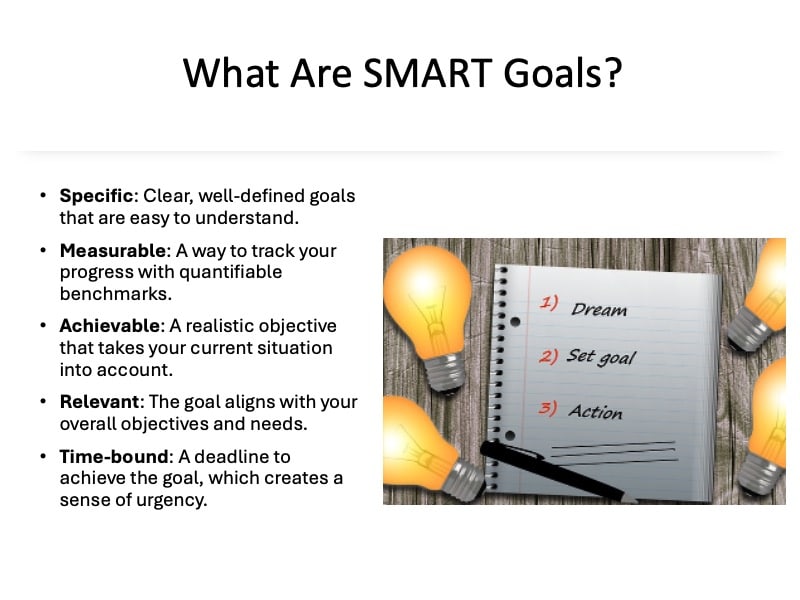
For example, aim to drink eight glasses of water per day for one week or cook dinner at home three nights this week.
Regardless, the key is to keep it simple and manageable.
Begin with just one or two small changes each week. Replace soda or sugary drinks with water or unsweetened herbal tea.
Swap white bread or rice for whole grain alternatives like brown rice or sprouted grain bread. Try prepping a basic salad with greens, olive oil, and a protein source—just once this week.
Focus on progress, not perfection. Building confidence through consistent, small wins will help you create long-term habits.
If cooking feels overwhelming, start with one meal per day—like breakfast—and gradually expand.
Keep nutritious snacks like fruit, trail mix, or Greek yogurt on hand to prevent impulsive decisions.
Simple, Sustainable Calorie Management
Rather than extreme restriction, adopt an intuitive eating mindset focused on nourishment, not deprivation.
Eat slowly, recognize true hunger and fullness cues, and prioritize nutrient density over numbers.
Portion Sizes vs. Serving Sizes
Use hand-based guidelines:
- Palm = Protein
- Fist = Veggies
- Cupped Hand = Carbs
- Thumb = Fat
Healthy Eating on a Budget
Many people think it is impossible to eat healthy and lose weight on a budget.
However, healthy food doesn’t have to break the bank.
With smart planning and strategic choices, eating well can be affordable and sustainable.
- Buy Frozen Fruits & Vegetables: They’re picked at peak ripeness and flash-frozen, often retaining more nutrients than fresh produce that’s traveled far.
- Choose Canned Foods Wisely: Beans, tomatoes, and fish (like sardines or salmon) are inexpensive, long-lasting, and packed with nutrition. Look for low-sodium or no-salt-added versions.
- Shop Local & In-Season: Farmers markets and seasonal produce are often cheaper and fresher.
- Buy in Bulk: Whole grains, oats, dried beans, and lentils are budget-friendly and shelf-stable.
- Cook at Home Often: Preparing meals at home drastically reduces food costs per serving and allows full control over ingredients and portion sizes.
- Use Leftovers Creatively: Turn dinner into tomorrow’s lunch, or repurpose cooked vegetables into soups, wraps, or grain bowls.
Planning meals and shopping with a list prevents food waste and cuts down on impulse buys.
Tailored Healthy Eating Advice for Different Lifestyles
Your lifestyle influences your nutritional needs. Adjusting your diet based on your daily demands can improve energy, focus, recovery, and overall health.
Athletes and Active Individuals
- Increase complex carbohydrates on high-intensity or long training days to fuel performance.
- Prioritize recovery meals with a 3:1 or 4:1 carb-to-protein ratio post-workout.
- Stay hydrated and consider electrolyte support during intense sessions.
- Incorporate anti-inflammatory foods like berries, leafy greens, and omega-3s to support joint and muscle recovery.
Busy Professionals
Trying to stay healthy at an office job can seem difficult due to work burnout and all the sitting that goes into office jobs, but here are a few healthy eating tips for busy professionals:
- Prepare grab-and-go meals in advance: overnight oats, grain bowls, smoothies, or salad jars.
- Keep healthy snacks at your desk to avoid vending machine temptations—nuts, dried fruit, protein bars.
- Set calendar reminders to drink water or eat a proper lunch to prevent skipping meals or binge eating at night.
- Opt for high-protein metabolism-boosting breakfasts to sustain energy and focus throughout the workday.
Seniors
- Focus on nutrients that support bone density and muscle mass: calcium, magnesium, vitamin D, and protein.
- Hydration is often overlooked—drink small amounts of water consistently throughout the day.
- Choose easy-to-chew, nutrient-dense options like soft-cooked vegetables, smoothies, soups, and stews.
- Add omega-3-rich foods for cognitive health support.
Kids & Teens
- Make healthy eating fun and visually appealing—use colorful fruits, bento box meals, or DIY snack stations.
- Offer a variety of textures and flavors to encourage curiosity and reduce picky eating.
- Include nutrient-rich finger foods like cheese cubes, apple slices with almond butter, or veggie sticks with hummus.
- Emphasize hydration and limit sugary drinks; opt for infused water or diluted juice.
Pregnant & Postpartum Women
- Focus on key nutrients like iron (to prevent anemia), folate (for fetal development), omega-3s (for brain development), and choline (for nervous system health).
- Stay well-hydrated to support blood volume and digestion.
- Incorporate small, frequent meals to manage nausea and energy dips.
- Choose high-protein, high-fiber foods to support tissue recovery and milk production postpartum.
- Consider prenatal supplements and consult a healthcare provider about nutritional gaps.
For postpartum weight loss, combining the basics of healthy eating with breastfeeding can quickly lead to healthy calorie deficits, which will help you lose weight and regain your pre-pregnancy body in a healthy way.
Psychology and Eating Habits
Lasting health isn’t just about what you eat—it’s about how you think, feel, and behave around food.
Understanding the psychology of eating habits and nutritional choices helps break cycles of emotional eating, all-or-nothing thinking, and diet fatigue.
By building awareness of your habits and developing mindful strategies, you can create a healthier relationship with food that feels sustainable—not restrictive.
Behavior change is the missing link between knowing what’s healthy and actually doing it consistently.
How to Structure Your Life for Healthy Eating
- Structure your environment for success
- Use habit stacking (e.g., water before coffee)
- Build routines, not rules
Mindful Eating Practices
- Sit down for meals without distractions
- Chew slowly and savor flavors
- Respect your body’s hunger signals
Long-Term Wins: This approach supports weight management, mood, and hormone health without diet fatigue or rebound weight gain.
Eating Out & Social Meals
- Review the menu ahead
- Share meals or box half early
- Ask for sauce/dressing on the side
Final Thoughts: Building a Life of Healthy Eating
Eating well isn’t about chasing perfection—it’s about creating sustainable routines that support how you want to feel and live.
By focusing on nutrient-dense foods, hydration, gut health, and mindful habits, you can transform your relationship with food and improve energy, longevity, and quality of life.
Start simple. Stay consistent. And remember: health is built one balanced meal at a time.
Frequently Asked Questions
- What is the simplest healthy meal I can make? Grilled chicken, steamed broccoli, sweet potato, olive oil drizzle.
- How many meals per day is best? Three meals, one to two snacks. Adjust as needed.
- Do I have to eat breakfast? No. Some thrive with intermittent fasting. Others need morning fuel.
- What are the best anti-inflammatory foods? Berries, greens, turmeric, ginger, olive oil, salmon.
- Can I be healthy if I don’t eat vegetables? Harder, but possible. Emphasize fruits, legumes, and supplements.
- How do I stop emotional eating? Journal triggers, eat consistently, practice mindfulness, seek support.
- Is snacking bad? No. Smart snacking can balance energy and reduce overeating.
- Can I eat dessert? Yes. Enjoy mindfully and occasionally.
- Clean vs. Balanced Eating? Clean = purity focus. Balanced = flexibility and variety.
- Are cheat meals okay? Yes. Balance, not perfection, matters.

